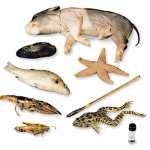Zoology
|
27 november 2015 11:52:18 |
| Heat stress related dairy cow mortality during heat waves and control periods in rural Southern Ontario from 2010–2012 (BMC Veterinary Research) |
|
Tweet Background:
Heat stress is a physiological response to extreme environmental heat such as heat waves. Heat stress can result in mortality in dairy cows when extreme heat is both rapidly changing and has a long duration. As a result of climate change, heat waves, which are defined as 3 days of temperatures of 32 °C or above, are an increasingly frequent extreme weather phenomenon in Southern Ontario. Heat waves are increasing the risk for on-farm dairy cow mortality in Southern Ontario. Heat stress indices (HSIs) are generally based on temperature and humidity and provide a relative measure of discomfort which can be used to predict increased risk of on-farm dairy cow mortality. In what follows, the heat stress distribution was described over space and presented with maps. Similarly, on-farm mortality was described and mapped. The goal of this study was to demonstrate that heat waves and related HSI increases during 2010–2012 were associated with increased on-farm dairy cow mortality in Southern Ontario.Mortality records and farm locations for all farms registered in the CanWest Dairy Herd Improvement Program in Southern Ontario were retrieved for 3 heat waves and 6 three-day control periods from 2010 to 2012. A random sample of controls (2:1) was taken from the data set to create a risk-based hybrid design. On-farm heat stress was estimated using data from 37 weather stations and subsequently interpolated across Southern Ontario by geostatistical kriging. A Poisson regression model was applied to assess the on-farm mortality in relation to varying levels of the HSI.
Results:
For every one unit increase in HSI the on-farm mortality rate across Southern Ontario increases by 1.03 times (CI
95%
(IRR) = (1.025,1.035); p = ≤ 0.001). With a typical 8.6 unit increase in HSI from a control period to a heat wave, mortality rates are predicted to increase by 1.27 times.
Conclusions:
Southern Ontario was affected by heat waves, as demonstrated by high levels of heat stress and increased on-farm mortality. Farmers should be aware of these risks, and informed of appropriate methods to mitigate such risks. |
| 99 viewsCategory: Medicine, Zoology |
 Genome-wide association study reveals a locus for nasal carriage of Staphylococcus aureus in Danish crossbred pigs (BMC Veterinary Research) Genome-wide association study reveals a locus for nasal carriage of Staphylococcus aureus in Danish crossbred pigs (BMC Veterinary Research)Biochemical and molecular investigation of thermal manipulation protocols during broiler embryogenesis and subsequent thermal challenge (BMC Veterinary Research) 
|
| blog comments powered by Disqus |
MyJournals.org
The latest issues of all your favorite science journals on one page
The latest issues of all your favorite science journals on one page



